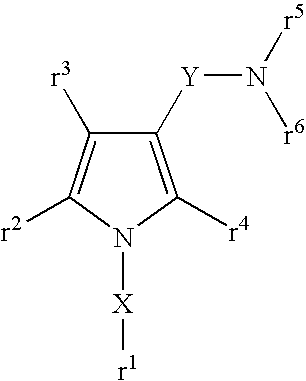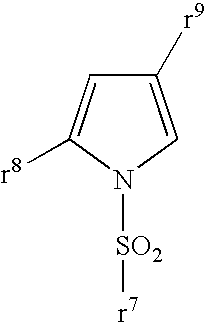Pyrrole compounds
a technology of pyrrole compounds and compounds, applied in the field of pyrrole compounds, can solve the problems of side effects and effects of proton pump inhibitors, and achieve the effect of easy isolation and purification
- Summary
- Abstract
- Description
- Claims
- Application Information
AI Technical Summary
Benefits of technology
Problems solved by technology
Method used
Image
Examples
reference example 1
5-bromo-1H-pyrrole-3-carbaldehyde
[0261]A solution of 1H-pyrrole-3-carbaldehyde (19.1 g) in tetrahydrofuran (300 mL) was cooled to −70° C., and a solution of N-bromosuccinimide (35.8 g) in N,N-dimethylformamide (100 mL) was added dropwise. After stirring at the same temperature for 1 hr, the mixture was warmed to −10° C. over 2 hr, and further stirred for 30 min. Ice water was added to the reaction mixture at 0° C., and the mixture was warmed to room temperature and extracted with ethyl acetate. The extract was washed with 10% aqueous citric acid solution, 6% aqueous sodium hydrogen carbonate solution and saturated brine, dried over anhydrous sodium sulfate, and concentrated under reduced pressure. The crystals obtained as a residue were washed with diisopropyl ether to give the title compound as colorless crystals (yield 17.7 g, 51%).
[0262]1H-NMR (CDCl3) δ: 6.65-6.66 (1H, m), 7.37-7.38 (1H, m), 8.80 (1H, br), 9.70 (1H, s).
reference example 2
5-bromo-1-(phenylsulfonyl)-1H-pyrrole-3-carbaldehyde
[0263]To a solution of 5-bromo-1H-pyrrole-3-carbaldehyde (3.50 g) in tetrahydrofuran (70 mL) was added sodium hydride (60% in oil, 1.21 g) at room temperature, and the mixture was stirred for 10 min. Benzenesulfonyl chloride (4.27 g) was added, and the mixture was further stirred for 1 hr, diluted with water, and extracted with ethyl acetate. The extract was washed with saturated brine, dried over anhydrous magnesium sulfate, and concentrated under reduced pressure. The residue was purified by silica gel column chromatography (eluent: hexane-ethyl acetate=4:1→7:3) and crystallized from diisopropyl ether to give the title compound as colorless crystals (yield 5.4 g, 85%).
[0264]1H-NMR (CDCl3) δ: 6.73 (1H, d, J=2.0 Hz), 7.58-7.63 (2H, m), 7.70-7.75 (1H, m), 7.98-8.01 (2H, m), 8.10 (1H, d, J=2.0 Hz), 9.77 (1H, s).
reference example 3
5-(2-fluoropyridin-3-yl)-1-(phenylsulfonyl)-1H-pyrrole-3-carbaldehyde
[0265]5-bromo-1-(phenylsulfonyl)-1H-pyrrole-3-carbaldehyde (3.15 g), (2-fluoropyridin-3-yl)boronic acid (2.83 g), sodium hydrogen carbonate (2.53 g) and tetrakis(triphenylphosphine)palladium (870 mg) were added to a deaerated mixture of 1,2-dimethoxyethane (80 mL) and water (20 mL), and the mixture was stirred under a nitrogen atmosphere at 80° C. for 5 hr. The reaction mixture was cooled, saturated aqueous sodium hydrogen carbonate solution was added, and the mixture was extracted with ethyl acetate. The extract was washed with saturated brine, dried over anhydrous magnesium sulfate, and concentrated under reduced pressure. The residue was purified by silica gel column chromatography (eluent: hexane-ethyl acetate=4:1→2:3) to give the title compound as a colorless oil (yield 2.25 g, 68%).
[0266]1H-NMR (CDCl3) δ: 6.71 (1H, d, J=1.7 Hz), 7.24-7.28 (1H, m), 7.42-7.48 (4H, m), 7.62-7.68 (1H, m), 7.70-7.76 (1H, m), 8.14 ...
PUM
 Login to View More
Login to View More Abstract
Description
Claims
Application Information
 Login to View More
Login to View More - R&D
- Intellectual Property
- Life Sciences
- Materials
- Tech Scout
- Unparalleled Data Quality
- Higher Quality Content
- 60% Fewer Hallucinations
Browse by: Latest US Patents, China's latest patents, Technical Efficacy Thesaurus, Application Domain, Technology Topic, Popular Technical Reports.
© 2025 PatSnap. All rights reserved.Legal|Privacy policy|Modern Slavery Act Transparency Statement|Sitemap|About US| Contact US: help@patsnap.com



